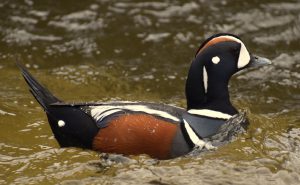
(Histrionicus histrionicus)
Physical Characteristics: Medium-sized duck, 12 inches long, 26 – inch wingspan, with small gray bill, short neck, and long tail. Evolutionary suited with smooth, densely packed feathers which provide buoyancy and insulation from cold water. Males are slate blue with chestnut sides and white markings bordered by black including a white crescent at base of bill. Male – female adults have white ear patch, though females are less colorful with brownish-gray plumage and white patch on head around eye.
Diet: Excellent divers; can also walk under water to collect aquatic insects, mollusks and larvae attached to rocks on river bottom. Often feed at creek mouths during Spring where they find salmon eggs.
Habitat: Prefer turbulent, highly-oxygenated water. Breed in fast-moving mountain streams at low-to subalpine elevations with closed forest canopy and midstream gravel bars or rocks for roosting. Wintering is spent along rocky (ocean) coastlines.
Range: Aleutian Islands in Alaska to northern California. Cooler/wetter climate of upper Clearwater Basin also provides habitat. Populations are routinely monitored on St. Joe and and Lochsa River; North Fork Spruce (tributary to Lochsa River) on Clearwater National Forest is suitable habitat too. Also known to nest on tributaries of N. Fork Clearwater and Selway Rivers. Believed to nest on S. Fork Clearwater and some tributaries of Salmon River on Nez Perce National Forest.
Reproduction: Slow to reach maturity; move east to breeding streams in late April – May. Before nesting make flights up – down streams for prospective sites. Nests are built close to water, carefully concealed in dense vegetation, among tree roots, or in rock crevices. Nesting females take advantage of evolutionary color patterns to avoid detection from mink, bears, eagles, otters, and other potential predators. After 5 – 7 eggs are laid, incubation begins and male returns to coast. Incubation lasts one month; chicks are lead to water within 24 hours of hatching. Chicks feed themselves by skimming surface and diving; 40 – 60 days before young can fly.
Threats: Habitat loss from road building/logging results in degraded water quality and reduction in food. Shoreline development, fishing (nets) and oil spills. Research indicates ducks experiencing reduced survival rates as result of Exxon Valdez oil spill. Hunting (along coastline) may be responsible for reduced populations in Clearwater. Currently listed as a “species of concern” on Nez Perce-Clearwater National Forests.
Miscellaneous: During breeding not unusual for females to combine broods and communally protect nests. Also called painted duck, totem pole duck, rock duck, glacier duck, white-eyed diver, squeaker, and blue-streak ducks.
Return to main Native Species page.